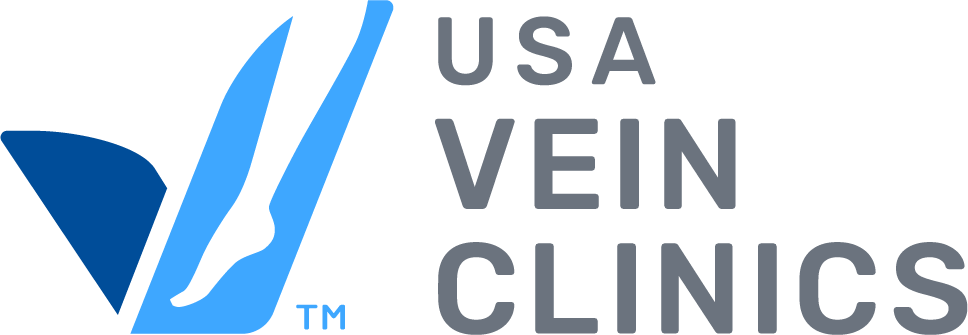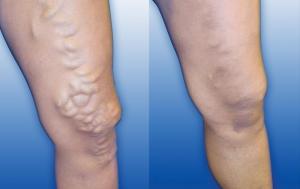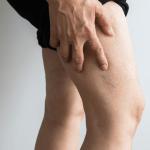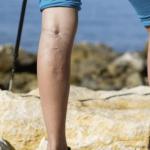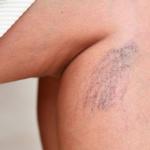
When searching for the best treatment for venous insufficiency, it’s natural to want a clear-cut answer. However, the most effective treatment is a personalized approach tailored to your condition, symptoms, and lifestyle.
Venous insufficiency, particularly chronic venous insufficiency (CVI), can result in leg pain, swelling, cramping, varicose veins, skin changes, and even ulcer formation. With a range of minimally invasive vein treatment options available, you can easily find symptom relief that’ll improve your quality of life. This guide will explore the range of effective options for chronic venous insufficiency (CVI), explain what makes a treatment effective, and why a customized plan from a vein specialist offers the most lasting relief.
Understanding Venous Insufficiency in the Legs
Venous insufficiency is when the veins, usually in the legs, struggle to return blood to the heart. Instead of flowing upward, blood pools in the lower legs.
This pooling leads to increased pressure and visible symptoms, such as:
- Swollen legs and ankles
- Aching or heaviness in the legs
- Varicose or spider veins
- Skin discoloration or ulcers near the ankles
- Cramping or burning sensations, especially at night
These life-interrupting symptoms are what typically lead people to seek treatment. Over time, when symptoms persist or worsen, the condition becomes known as chronic venous insufficiency (CVI). While the terms are often interchangeable, CVI refers specifically to the long-term, progressive form of the disease.
Best Venous Insufficiency Treatment
The most effective treatment for venous insufficiency in the legs is the one that can effectively alleviate symptoms before they worsen. The best venous insufficiency treatment not only improves the appearance of the legs but also helps prevent complications, allowing you to return to the activities you enjoy.
Minimally Invasive Treatments for CVI & Their Benefits
Minimally invasive, outpatient procedures have established the gold standard for treating chronic venous insufficiency. These techniques don’t require general anesthesia, stitches, or extended hospital stays. More importantly, they offer a fast recovery, high success rates, and long-term relief from painful symptoms.
Ultrasound-Guided Sclerotherapy (USGS)
Ultrasound-guided sclerotherapy (USGS) is a treatment for venous insufficiency in the legs for moderate to severe varicose veins. An ultrasound guides a sclerosant injection into problem veins, causing them to collapse. Blood is then rerouted through healthy veins.
Most patients can expect a shorter recovery period and avoid scarring from the procedure. Typically, patients can return to light activities the same day.
The main benefits of ultrasound-guided sclerotherapy include:
- Published clinical studies indicate that ultrasound-guided sclerotherapy is highly effective, with success rates typically ranging from 85% to 93% in experienced hands.
- Minimally Invasive: It is a non-surgical, “walk-in, walk-out” outpatient procedure that does not require incisions, stitches, or general anesthesia.
- High precision and Effectiveness: The use of ultrasound imaging allows treatment of deeper or hidden veins affected by vein disease
- Minimal downtime and quick recovery
- Excellent for restoring proper circulation and reducing symptoms.
Visual Sclerotherapy
Visual sclerotherapy targets smaller varicose and spider veins near the surface. This treatment for chronic venous insufficiency involves injecting a solution directly into the visible vein, causing it to close. Recovering from visual sclerotherapy may include mild bruising or swelling, but the effects are temporary, and there is usually minimal disruption to your daily routine.
The benefits of visual sclerotherapy include:
- Noticeable relief from symptoms like leg fatigue, cramping, and itching
- Decreases the risk of complications like ulcers and blood clots
- Enhances comfort, mobility, and cosmetic appearance
Endovenous Laser Therapy (EVLT)
Endovenous Laser Therapy (EVLT) treats chronic venous insufficiency and large varicose veins by using a thin laser fiber that’s inserted into the vein, using laser energy to seal the vein shut. This treatment for venous insufficiency in the legs is performed with local anesthesia, and there will likely be some minor soreness.
The benefits of EVLT include:
- 98% success rate in closing faulty veins
- Minimal side effects and no scarring
- Shorter recovery and reduced risk of DVT
- Rapid improvement in symptoms and vein health
Radiofrequency Ablation (RFA)
Radiofrequency ablation (RFA) is a treatment for venous insufficiency in the legs that gently heats and closes damaged veins using radiofrequency energy through a catheter. This outpatient procedure allows you to walk out the same day, eliminating the need for extensive recovery time.
RFA’s benefits include:
- Targets the root cause, not just symptoms
- Quick and virtually painless
- Safe for many patients and only requires local anesthesia
- Proven to reduce heaviness, pain, and swelling in the legs
VenaSeal™ Closure System
The VenaSeal™ Closure System permanently seals diseased veins using a medical adhesive. A small catheter delivers a special glue that closes the vein. No compression stockings are necessary for recovery, and you can resume your normal activities quickly.
Other benefits of VenaSeal™ Closure System include:
- No heat or local anesthesia
- Fast relief and almost no downtime
- Less bruising or discomfort compared to thermal options
- Performed entirely in-office under local anesthesia
ClariVein®
ClariVein® treatment for chronic venous insufficiency uses an FDA-approved medical device, also known as the ClariVein® Infusion Catheter, or ClariVein®-IC. During this procedure, the catheter delivers a special medication to diseased veins using a tiny rotating wire catheter. This treatment typically takes less than 30 minutes and does not require laser heat or anesthesia.
The benefits of ClariVein® include:
- Virtually painless with little to no recovery period
- Minimal bruising compared to thermal treatments
- Quick in-office treatment, get back to your life in less than an hour
- No scarring
Varithena
Varithena treats veins by using foam. During this non-surgical procedure, a vein specialist injects the Varithena foam into the diseased veins, causing the problem veins to collapse and reroute blood flow to healthier veins. This treatment requires no incisions and typically takes less than an hour.
Varithena benefits include:
- Minimally invasive with no need for laser heat or anesthesia
- No downtime, return to work immediately after your treatment
- Significant improvement in vein appearance and discomfort
- Safe, effective, and FDA-approved
Explore Our Full List of Vein Treatments
At-Home Management and Lifestyle Changes
In addition to receiving medical treatment for chronic venous insufficiency, adopting a healthy lifestyle can help maintain your results and prevent recurrence.
If you’re looking for a way to manage venous insufficiency at home, you can try:
- Wearing compression stockings to support circulation
- Elevating your legs above heart level several times a day
- Staying active with walking or low-impact exercises
- Avoiding prolonged standing or sitting
- Maintaining a balanced diet and a healthy weight
Although these changes can help support temporary symptom relief, they won’t cure venous insufficiency. They work best in conjunction with a personalized treatment plan.
How to Reverse Venous Insufficiency
While you cannot completely reverse venous insufficiency, its symptoms can be significantly improved with the right approach. Timely intervention prevents progression, reduces discomfort, and restores daily function.
With proper treatment and lifestyle adjustments, many patients experience long-term relief and avoid complications such as ulcers or blood clots. If you’ve noticed even mild symptoms, schedule a consultation with a vein specialist.
When to Seek Venous Insufficiency Treatment
Recognizing when to seek treatment for venous insufficiency is critical to your health and quality of life. Early symptoms may seem mild or merely cosmetic, but they can quickly progress if they’re left unaddressed. What starts as occasional leg discomfort or swelling can develop into persistent pain, skin changes, or even open sores that fail to heal.
If you’re experiencing any of the following symptoms, consult a vein specialist:
- Persistent leg pain, swelling, or heaviness
- Bulging, twisted veins
- Skin discoloration, itchiness, or hardening
- Open sores or ulcers near the ankles
- Blood clots or a history of DVT
If it’s left untreated, venous insufficiency can lead to serious complications and, in some cases, become chronic. The earlier you seek the best venous insufficiency treatment for your vein health, the more options and the better outcomes you’ll have.
Get Lasting Symptom Relief With USA Vein Clinics
USA Vein Clinics specializes in personalized treatment for venous insufficiency. Our experienced vein specialists take the time to evaluate your symptoms, medical history, and vein health using advanced diagnostic tools.
We offer:
- Minimally invasive, outpatient treatments
- Nationwide clinics for easy access
- Non-surgical options are performed with local anesthesia
- Accredited care from experienced vascular specialists
- Fast recovery, with most patients returning to activities the same day
While general physicians can identify symptoms, only a vein specialist can offer the full spectrum of diagnostic imaging and advanced treatments necessary for long-term relief.
Schedule Your Consultation Today
If you’re ready to find the best venous insufficiency treatment, schedule a consultation today. With over 168 nationwide locations, effective vein care has never been more accessible. Get back on track toward better vein health and enjoying life with fewer limitations.
